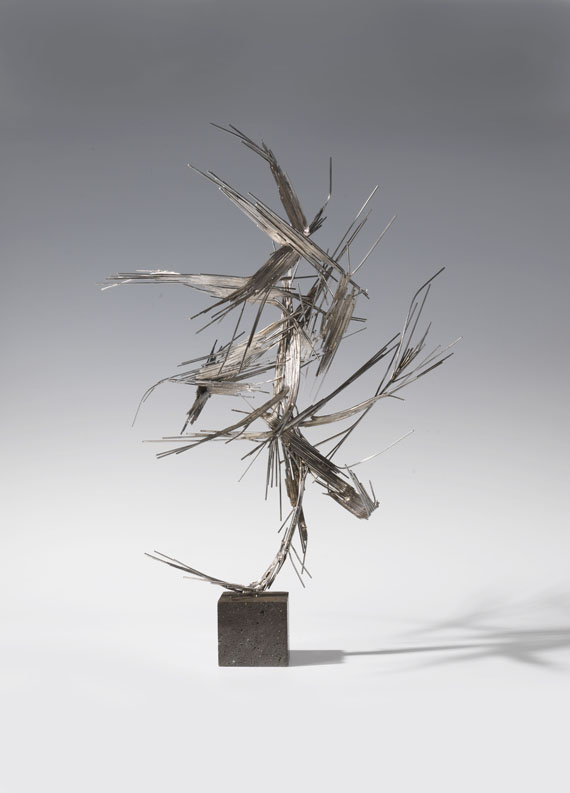Autre image
Autre image
Autre image
268
Norbert Kricke
Raumplastik, 1961.
Sculpture
Estimation:
€ 50,000 / $ 58,000 Résultat:
€ 152,500 / $ 176,900 ( frais d'adjudication compris)
Raumplastik. 1961.
Sculpture. Stainless steel on stone base.
Unique piece. Plastic: ca. 58 x 46 x 49 cm (22,8 x 18,1 x 19,2 in). Base: 8 x 8,5 x 8,9 cm (3,1 x 3,3 x 3,5 in).
PROVENANCE: Galerie Flinker, Paris.
EXHIBITION: 60 Jahre, 60 Werke. Kunst aus der Bundesrepublik Deutschland 1949 - 2009, Martin-Gropius-Bau, Berlin, 1 May - 14 June, 2009 (with illu. p. 93).
Norbert Kricke was born in Düsseldorf on 30 November 1922. After 1947 - following his studies with Richard Schreibe at the Hochschule für Bildende Künste in Berlin - Kricke established himself as freelance artist in Düsseldorf. Towards the end of the 1940s he followed in the footsteps of other constructivist artists of the likes of Naum Gabo and Antoine Pevsner and produced his first sculptures made of straight, bundled or tied up metal rods, welded together and reaching out dynamically into space. In 1953 his first solo exhibition took place at the Galerie Ophir in Munich. In 1956 he collaborated with John Anthony Thwaites on an outlined of their theories called 'Forms of Water'. In the following year Kricke was awarded the 'Wettbewerb zur künstlerischen Gestaltung' of the Neue Stadttheater Gelsenkirchen along with Robert Adams and Yves Klein. At the same time he took part in the 'Salon des Réalités Nouvelles' in Paris. As from 1955 Kricke received international public commissions, i.e., a large sculpture for the new opera building in Münster (1955/56), the design for the new state theatre in Gelsenkirchen (1957) and in collaboration with Walter Gropius the water lay-out for the new university building in Baghdad (1959) as well as the large sculpture in front of the County Museum of Art, Los Angeles (1965).
With his fragile and agravic spatial plastics, Norbert Kricke is able to visualize space and time. This work’s shiny metal rods sprawl in all directions like rays of light and simulate dimension and motion: "My problem is not mass nor figure, but space and motion – space and time. I don’t want real space nor real motion (mobile), I want to illustrate motion. I am searching to give form to a unity of space and time." (Norbert Kricke 1954, transl. of quote after: Künstler Kritisches Lexikon der Gegenwartskunst, edition 2, p. 2).
As one of the most important representatives of informel sculpting in Germany, Kricke's oeuvre was not only shown on several documenta exhibitions, he also received international recognition as early as in the 1960s, through, for instance the 32nd Biennale in Venice or an exhibition in the Museum of Modern Art in New York. In 1964 he accepted a chair for sculpture and in 1972 the directorship of the Staatliche Kunstakademie Düsseldorf , a post he helf for ten years as of 1972. Norbert Kricke died in his hometown on 26 June 1984. [KH].
Sculpture. Stainless steel on stone base.
Unique piece. Plastic: ca. 58 x 46 x 49 cm (22,8 x 18,1 x 19,2 in). Base: 8 x 8,5 x 8,9 cm (3,1 x 3,3 x 3,5 in).
PROVENANCE: Galerie Flinker, Paris.
EXHIBITION: 60 Jahre, 60 Werke. Kunst aus der Bundesrepublik Deutschland 1949 - 2009, Martin-Gropius-Bau, Berlin, 1 May - 14 June, 2009 (with illu. p. 93).
Norbert Kricke was born in Düsseldorf on 30 November 1922. After 1947 - following his studies with Richard Schreibe at the Hochschule für Bildende Künste in Berlin - Kricke established himself as freelance artist in Düsseldorf. Towards the end of the 1940s he followed in the footsteps of other constructivist artists of the likes of Naum Gabo and Antoine Pevsner and produced his first sculptures made of straight, bundled or tied up metal rods, welded together and reaching out dynamically into space. In 1953 his first solo exhibition took place at the Galerie Ophir in Munich. In 1956 he collaborated with John Anthony Thwaites on an outlined of their theories called 'Forms of Water'. In the following year Kricke was awarded the 'Wettbewerb zur künstlerischen Gestaltung' of the Neue Stadttheater Gelsenkirchen along with Robert Adams and Yves Klein. At the same time he took part in the 'Salon des Réalités Nouvelles' in Paris. As from 1955 Kricke received international public commissions, i.e., a large sculpture for the new opera building in Münster (1955/56), the design for the new state theatre in Gelsenkirchen (1957) and in collaboration with Walter Gropius the water lay-out for the new university building in Baghdad (1959) as well as the large sculpture in front of the County Museum of Art, Los Angeles (1965).
With his fragile and agravic spatial plastics, Norbert Kricke is able to visualize space and time. This work’s shiny metal rods sprawl in all directions like rays of light and simulate dimension and motion: "My problem is not mass nor figure, but space and motion – space and time. I don’t want real space nor real motion (mobile), I want to illustrate motion. I am searching to give form to a unity of space and time." (Norbert Kricke 1954, transl. of quote after: Künstler Kritisches Lexikon der Gegenwartskunst, edition 2, p. 2).
As one of the most important representatives of informel sculpting in Germany, Kricke's oeuvre was not only shown on several documenta exhibitions, he also received international recognition as early as in the 1960s, through, for instance the 32nd Biennale in Venice or an exhibition in the Museum of Modern Art in New York. In 1964 he accepted a chair for sculpture and in 1972 the directorship of the Staatliche Kunstakademie Düsseldorf , a post he helf for ten years as of 1972. Norbert Kricke died in his hometown on 26 June 1984. [KH].
268
Norbert Kricke
Raumplastik, 1961.
Sculpture
Estimation:
€ 50,000 / $ 58,000 Résultat:
€ 152,500 / $ 176,900 ( frais d'adjudication compris)




 Lot 268
Lot 268 